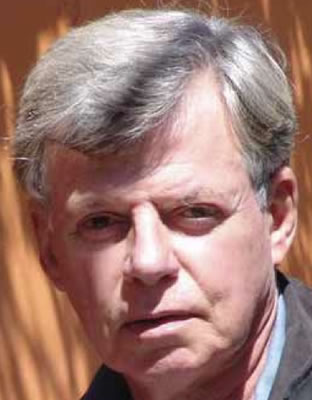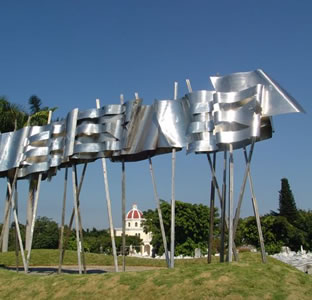Cuban architect, urban designer, critic speaks on Havana architecture Nov. 16


Architect/urban designer Mario Coyula and his sculpture "Mausoleo 13 Marzo"


Architect/urban designer Mario Coyula and his sculpture "Mausoleo 13 Marzo"
(Nov. 10, 2011) -- Cuban architect, urban designer and critic Mario Coyula will speak on "The Many Centers of Havana," at 5:30 p.m., Wednesday, Nov. 16 in the Buena Vista Street Building Aula Canaria (1.328) on the UTSA Main Campus. The talk is free and open to the public.
As the third speaker in the UTSA College of Architecture Fall Lecture Series, Coyula will challenge the conventional wisdom of Havana as a monocentric city, examining it instead as a polycentric structure created around a system of squares rather than a single main square.
A noted authority on the history and preservation of Havana, Coyula has been directly involved in issues of urban planning, government and design in the capital city for many years. Presently, he is a visiting scholar at the David Rockefeller Center for Latin American Studies at Harvard University.
In his second stint as a Harvard visiting professor, Coyula was a Robert F. Kennedy Visiting Professor from 2002 to 2003 at the Graduate School of Design. Currently, Coyula is researching old master plans of Havana contained in Harvard's archives. Access to the plans previously not accessible to Coyula will heighten his scholarly work regarding the intentions of the master planners and the decisions they made concerning Havana.
Though Havana's unique political history has stunted infrastructure growth, it also helped to create the unique, vibrant metropolis with incredible neighborhoods and buildings dating to the 16th century. Coyula will discuss how newer centers began to appear west of the original center by the bay and how they survived with divergent inhabitants.
The traditional centers have suffered from the loss of function, disinvestment, disrepair and partial marginalization as many stores were closed or changed into makeshift dwellings to shelter homeless people. At the same time, vacant mansions in formerly upscale neighborhoods were abandoned by wealthy residents and turned into stores, dwellings and hotbeds of activity for the poor and lower middle class.
A man of college age during the Revolution -- he was 24 years old in 1959 -- Coyula was an active participant in the affairs of his time. One of his most significant commissions is "Panteón del 13 de Marzo," a memorial installation in the Colón Cemetery that is dedicated to the revolutionaries, his peers, killed in the attack on the Presidential Palace on March 13, 1957.
In addition to being the 2001 recipient of the National Prize of Architecture, he is the former director of the Ciudad Universitaria José Antonio Echeverría School of Architecture and the Architecture and Urban Planning Department of Havana, as well as the Group for the Integral Development in Havana. Coyula is the co-author of "Havana: Two Faces of the Antillean Metropolis" with Roberto Segre and Joseph L. Scarpaci.
"Mario's research on urban planning and 20th-century development in Havana is highly significant because he has lived and practiced there for his entire career, and there is no more notable or highly regarded Cuban author publishing on this topic," said William Dupont, UTSA San Antonio Conservation Society Endowed Professor and director of the Center for Cultural Sustainability. "Mario's depth of professional experience, coupled with his straightforward explanations, provides an excellent history of Havana's growth and change, also offering keen insight into the current urban situations in all parts of the city."
------------------------------
For more information, email Nicole Chavez.
Events
This event will acknowledge graduating seniors from the McNair Scholars program at UTSA before inducting the new cohort of scholars into the program.
North Paseo Building (NPB 5.140), Main CampusAt this memorable celebration, UTSA graduates will be introduced one-by-one to cross the stage and accept their doctoral degrees.
Arts Building Recital Hall, Main CampusRoadrunner Walk is an event for graduating students to have a memorable walk on campus to celebrate an important milestone and their achievements. Graduates will walk along the Paseo while being celebrated by the UTSA community, friends, and family members.
Student Union Paseo, Main CampusCelebrate the accomplishments of College of Education and Human Development, College for Health, Community and Policy, College of Sciences and University College.
Alamodome, 100 Montana St.Celebrate the accomplishments of Alvarez College of Business, College of Liberal and Fine Arts and Klesse College of Engineering and Integrated Design.
Alamodome, 100 Montana St.

